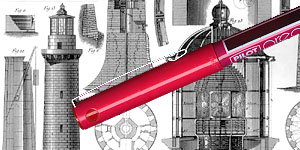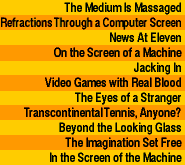


On the Screen of a Machine
In darkened room, a young woman sits crosslegged before a keyboard and a large glowing screen. We can see a small rectangle in the screen's upper left corner---a well-known news announcer solemnly mouths the day's news, unheard. Above the announcer blinks the date: December 20, 2006. A small Japanese kabuki mask grins in the screen's opposite corner.The woman isn't looking at the news broadcast or at the mask. She is looking into another part of the screen, a soaring view from above of a huge green-and-yellow checkerboard of waving grain. The scene is so perfectly rendered that when she presses a key, we feel as if we are rising from the surface in a silent helicopter. The motion is smooth and perfect, with none of the jerkiness of normal motion. When it stops, we notice a tiny animal picking its way across the fields far below.
Now the woman gestures with her right hand and we see that she is moving a small curved box on the floor---a computer mouse. As her hand moves we seem to swoop down toward the animal and land some distance in front of it. It is a dinosaur. The viewpoint changes and now we are looking up at the huge surreal dinosaur---a Tyrannosaurus Rex---as it soundlessly strides by overhead casting its shadow all around us. We now see that it isn't real; it is smooth and perfect, like a giant soft plastic toy. It flexes and shifts as it glides by, its legs working with Victorian clockwork precision.
In the top left window, the famous newscaster is replaced by a cartoon, and the audio cranks itself up. "This just in," the cartoon says in a synthesized voice, grinning insanely, "Your buyer has found a pair of vases at auction in Sydney. They are available at the price you specified. Do you wish to verify your bid?"
The woman gestures with her right hand, and the dinosaur scene vanishes, revealing many smaller rectangles filled either with text or otherworldly scenes. Each window is a view onto another world. The woman types something with both hands. Suddenly the kabuki mask frowns slightly, mirroring the computer's surge of effort. A new window blinks onto the screen, showing an image of two vases sitting in a room on the other side of the world. The camera rotates slowly around the vases, showing them from all directions. The video image is blocky and slightly stuttering, clearly not as well rendered as the artificial dinosaur scene.
The woman grins and types some more. A softly lit room with angular furniture appears, displacing all the other windows on the screen. Unlike the glowing dreamlike dinosaur, this image looks like a photograph. The wood floor has the texture and color of some dark oak; it looks slightly scuffed, as if from too many people with hard shoes. Familiar paintings adorn the walls, and copper and brass accents glint on their frames.
We can see light refracting through a heavy glass table squatting in the middle of the room, breaking the lines of the chair behind it. A small brass halogen lamp casts a bright light pool on the woven rug, and the shadows cast by the table legs fade off into the room's dark corners. Then the scene changes slightly. The pool of light becomes more diffuse, and the shadowed corners of the room brighten slightly. We notice highlights and reflections on the glass. As the viewpoint changes, we gradually stop seeing the image as a photograph and start, unconsciously, thinking of it as a doorway into a real place. That particular real place, however, exists only inside a computer.
The woman appears uncertain. She reaches for a pair of thin gloves with wires trailing from them that lies next to the screen in the otherwise empty room. She waves her gloved right hand and it appears as though she has somehow reached in and placed one of the vases on the table, for we can now see sketches of her hands in the scene, moving in time with her gestures. She reaches again for something we can't see and the vase is filled with bright flowers, azaleas and chrysanthemums.
Smiling, the woman dons what looks like a pair of wraparound sunglasses---which also trails wires---and stands up. Turning around she appears not to see us; it's as if she is now in the room on the screen, for we see her cartoon image suddenly appear in it. She walks about the imaginary room, surveying her handiwork. Apparently dissatisfied, she points to one of the heavy, craftsman-style benches and it follows her gesture, scuttling over to another wall. She points again and two chairs walk by the table and snap into position around it. She snaps her fingers, says "Color cube," and a three-dimensional multicolored cube about the size of her head appears in front of her, slowly tumbling end over end in space. She points to one part of the cube and then to the flowers in the vase and they change to more subdued white roses and pale pink lilacs.
Finally satisfied with her job, the interior designer flips an imaginary switch in the air with her gloved left hand. The kabuki mask smiles, and, as it does, music wells up and the woman begins to dance in the bare room. And her image is also dancing in the richly furnished room, on the screen of the machine.